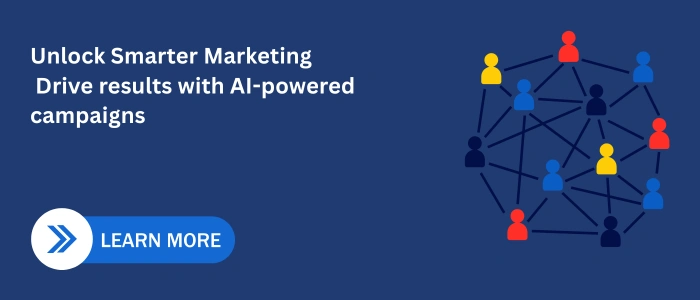Introduction
Generative AI is reshaping marketing by enabling brands to create personalized campaigns, scale content, and improve customer engagement with speed and accuracy. From writing ad copy to optimizing emails and social posts, it helps marketers achieve better results with less effort.
But adopting AI effectively requires more than just tools. Businesses need structured implementation, data integration, and compliance. This is where AI development services play a key role helping companies build scalable AI solutions, integrate them with existing MarTech systems, and ensure campaigns are secure, measurable, and future-ready.
Marketing Architecture with Generative AI
Generative AI is changing how campaigns are designed, tested, and delivered. But the technology only works when supported by a clear marketing architecture. A structured approach ensures scalability, compliance, and measurable outcomes.

Data & Consent Layers (CDP, CRM, Privacy)
Every AI-driven campaign begins with customer data. The effectiveness of personalization depends on both data quality and consent management.
- Consent tracking: Regulations such as GDPR and CCPA make compliance non-negotiable. Modern Customer Data Platforms (CDPs) allow marketers to track, update, and audit consent in real time.
- Segmentation: Audience groups should be structured by behavioral triggers, purchase history, or engagement patterns. Segmentation improves prompt accuracy and output relevance.
- Enrichment: APIs can connect external datasets such as browsing history, device type, or demographic insights, which allow models to generate content with greater precision.
When these layers are missing, personalization efforts can backfire, leading to mistrust or even fines.
Orchestration & Workflow Engines
AI tools must fit into existing operations. Orchestration engines handle the connection between models and marketing channels.
- APIs and microservices: These connect generative AI systems with platforms such as HubSpot, Mailchimp, or Google Ads.
- Agents and automation: AI agents can generate draft campaigns, schedule posts, or run tests. For example, an agent can create five ad copies, assign them to test groups, and recommend the best-performing variation.
- Human-in-the-loop checkpoints: Despite automation, brand voice must be reviewed before publishing. Teams that skip this step risk reputational damage.
Integration with MarTech Stack
Generative AI should strengthen existing investments rather than replace them.
- ESP (Email Service Providers): AI can suggest subject lines, test CTAs, and adjust tone.
- CMS (Content Management Systems): Draft blogs, FAQs, and landing pages that pass compliance checks.
- AdTech platforms: Generate hundreds of ad variations with minor changes in copy or visuals, making large-scale personalization practical.
This layered design data, orchestration, integration delivers efficiency while maintaining reliability.
Practical Use Cases Across Channels
Generative AI can be applied to every major marketing channel. When deployed properly, it reduces manual effort while improving performance.
Email Marketing: Copy, Subject Line, Testing
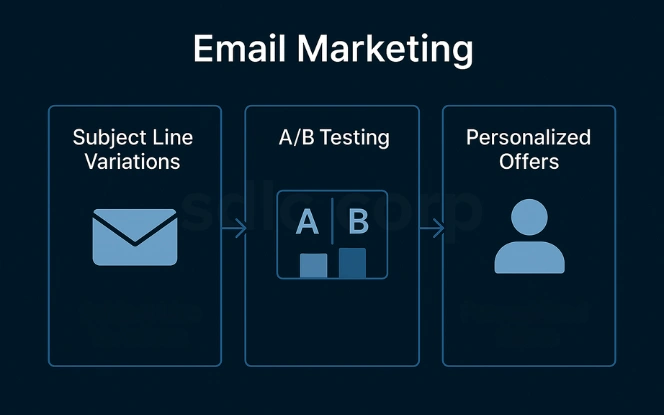
Email remains one of the highest ROI channels, with $36 returned for every $1 spent. Generative AI enhances this channel by:
- Writing multiple subject line variations allows marketers to test for higher open rates.
- Drafting body copy with dynamic placeholders that adapt to segments.
- Producing automated A/B test variations that reduce cycle times.
Marketers who previously spent hours on email drafts can now launch tests in minutes.
Social Media & Ads: Visuals, Headlines, CTAs
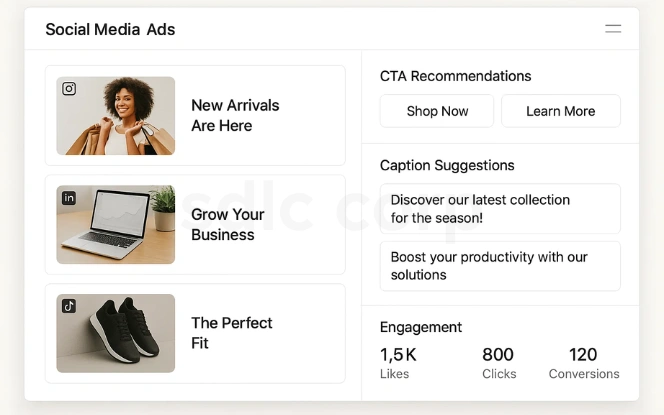
Generative AI thrives in environments that demand speed and variety.
- Ad creative generation: Models can produce headlines and visuals tailored to Instagram, LinkedIn, or TikTok.
- CTA optimization: AI analyzes past engagement data to recommend CTAs with stronger conversion potential.
- Caption generation: Tools like Jasper and Copy.ai already provide templates that reflect platform tone.
This allows small teams to manage enterprise-scale social campaigns.
SEO & Content Marketing: Long-form, GEO Optimization

Organic content takes time and resources. AI reduces this workload while introducing new optimization strategies.
- Long-form drafts: AI can produce 1,500-word outlines aligned with target keywords.
- Generative Engine Optimization (GEO): Instead of focusing only on Google, marketers now optimize for AI-driven engines like ChatGPT and Perplexity. That means creating content structured in Q&A format.
- Snippet-ready content: Adding FAQ blocks improves visibility in both search results and AI-generated summaries.
This ensures brand presence across both traditional and AI-driven discovery.
Prompt Engineering Playbooks

Prompt Templates for Campaigns
Effective prompts are specific, contextual, and measurable.
- Email: “Write a 100-word email for a re-engagement campaign offering 15% off. Audience: inactive users for 90 days. Tone: friendly but professional.”
- Ads: “Generate 5 ad headlines under 30 characters for a holiday campaign. Include urgency but avoid exaggeration.”
- Email: “Write a 100-word email for a re-engagement campaign offering 15% off. Audience: inactive users for 90 days. Tone: friendly but professional.”
Guardrails & Brand Safety
AI tools can generate risky outputs if not guided. Marketers must add guardrails:
- Include tone, style, and banned phrases within prompts.
- Add instructions like: “Avoid sensitive or political references.”
- Require every draft to run through compliance checks before approval.
Multi-turn Workflows (Prompt Chaining)
Single prompts rarely deliver publish-ready results. Chaining creates refinement:
- Step 1: Draft an outline with headings.
- Step 2: Expand each section with detailed copy.
- Step 3: Optimize text for readability and SEO.
This mirrors a human editorial process, making outputs stronger and more usable.
Risks, Ethics & Compliance

Data Privacy & Global Regulations
Customer trust is built on data safety.
- Track and store user consent records.
- Avoid exposing personal data to third-party AI services.
- Use anonymization before sharing datasets with external tools.
Bias & Representation in AI Content
AI models reflect training data, which may carry biases.
- Review outputs for unintended stereotypes.
- Test campaigns for inclusive representation across demographics.
Disclosure Policies for AI-Generated Copy
Brands must remain transparent.
- Add disclaimers when large portions of text or visuals are AI-assisted.
- Document workflows so compliance teams can audit campaigns if needed.
- Ignoring disclosure increases both legal and reputational risk.
Measuring ROI & Performance
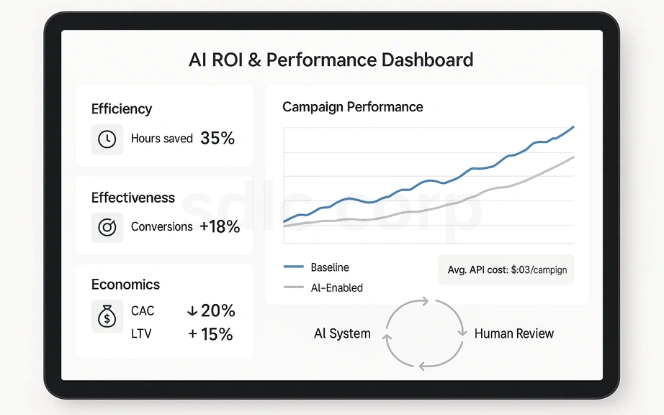
Marketers must justify investment in AI. Tracking ROI requires structured KPIs.
KPI Framework
- Efficiency: Reduction in hours spent per campaign.
- Effectiveness: Lift in open rates, conversions, or CTR.
- Economics: Reduction in CAC (Customer Acquisition Cost) and increase in LTV (Lifetime Value).
Feedback Loops & Human-in-the-Loop Checks
- Campaign outcomes should be fed back into the AI system to refine prompts.
- Human review teams ensure outputs stay aligned with strategy.
Cost Estimation & Benchmarking
- Cloud-based APIs charge per token, often a few cents per campaign.
- Enterprises must weigh subscription fees against team productivity gains.
- Benchmarks should compare AI-enabled results with baseline campaigns.
This ensures decision-makers see both cost savings and revenue impact.
Explore More- AI for gaming
Advanced Trends & Future Outlook
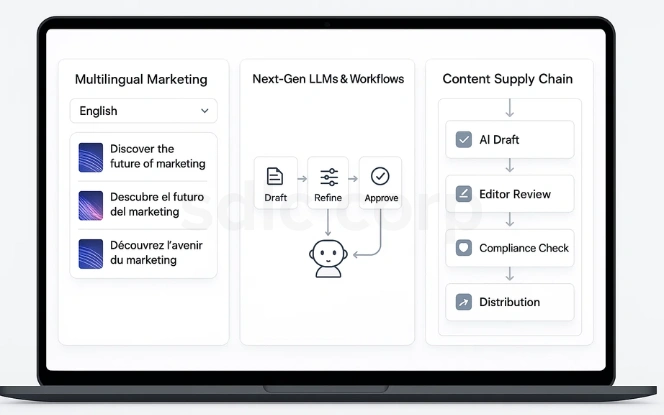
The generative AI landscape evolves rapidly. Marketers must prepare for upcoming shifts.
- Multilingual Marketing & Localization
AI can translate and adapt campaigns while preserving tone and context. For example, one prompt can create region-specific ad variations without requiring separate teams.
- Next-Gen LLMs & Agentic Workflows
Large Language Models are moving from text generation to agent-based workflows. These systems can autonomously manage entire campaigns, from drafting to reporting, with minimal oversight.
- Content Supply Chains at Scale
Enterprise marketers are already deploying AI-powered pipelines:
- AI drafts a campaign.
- Editors refine tone.
- Compliance tools validate language.
- Platforms are distributed across channels.
This reduces bottlenecks, improves consistency, and shortens time-to-market.
Explore More- Vector Databases for AI
Conclusion
Generative AI is now central to modern marketing. It helps brands automate campaigns, personalize customer journeys, and scale content production with speed and accuracy. Businesses that adopt it strategically gain stronger engagement and measurable ROI, while those who delay risk falling behind competitors.
Still, success requires more than technology it needs expertise. Partnering with the right team or choosing to hire AI developers ensures proper integration, compliance, and scalability. With skilled support, your business can transform marketing processes into future-ready, data-driven strategies that deliver consistent results
FAQ's
What Are The Best Generative AI Tools For Marketers?
Leading options include Jasper, Copy.ai, Adobe Firefly, and Salesforce Einstein. Selection depends on use case content creation, ad generation, or personalization.
Can Small Businesses Use Generative AI In Marketing?
Yes. SMBs benefit from affordable platforms offering templates and guided workflows, making advanced campaigns possible without large teams.
How Much Does It Cost To Implement Generative AI In Campaigns?
Entry-level costs start at a few cents per API query. Enterprise systems may range from thousands to millions annually, depending on integrations and scale.
Generative AI Vs Traditional Marketing Automation – What’s The Difference?
Traditional automation follows set rules. Generative AI creates new copy, visuals, and strategies dynamically, adapting to context and goals.
How Can Marketers Ensure Ethical And Compliant Use Of Generative AI?
By following GDPR and CCPA standards, using consented data, adding bias checks, and maintaining human review before publishing AI-generated content.


